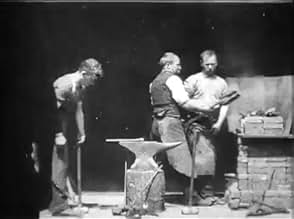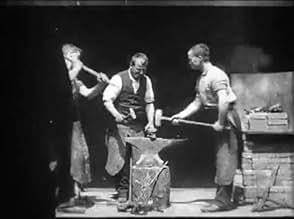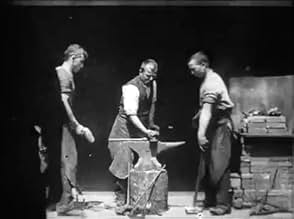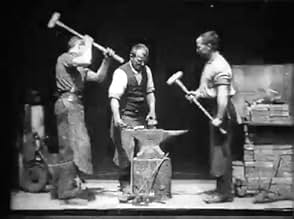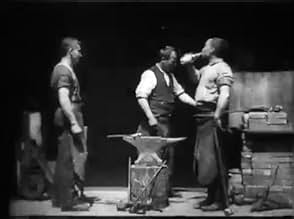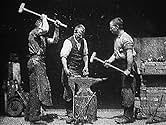Ajouter une intrigue dans votre langueThree men hammer on an anvil and pass a bottle of beer around.Three men hammer on an anvil and pass a bottle of beer around.Three men hammer on an anvil and pass a bottle of beer around.
- Réalisation
- Casting principal
- Récompenses
- 1 victoire au total
Charles Kayser
- Blacksmith
- (non crédité)
Avis à la une
All right, so it's short on plot. But just the fact of this Edison-studio produced film is enough to make it an award-winner. It doesn't have the same pathos as the Edison clip of men dancing used to such great effect in "The Celluloid Closet," but how can you not love a century-old example of "Miller Time"?
'Blacksmith Scene (1893)' was one of the first commercially-exhibited motion pictures, filmed in April 1893 and first screened publicly at the Brooklyn Institute on May 9, 1893. The set-up is pretty simple: three blacksmiths (actually employees of Thomas Edison) start hammering away at a heated metal rod and an anvil, before pausing to pass around a bottle of beer. The acting from two of the performers is convincing enough; the third blacksmith, on the left, doesn't even pretend that the beer bottle contains any liquid, briefly pressing the rim to his mouth and then removing it without even the pretence of drinking. The film's first seven seconds have the silhouette of a fourth party blocking the left side of the frame, before somebody presumably told him to get out of the way. While watching this didn't give me the same thrill as the Lumière brothers' 'Arrival of a Train at La Ciotat (1895),' 'Blacksmith Scene' is still an important historical curiosity. I'm grateful that the National Film Registry always remembers to honour and preserve even these apparently-innocuous snippets of cinema history.
It's always fascinating to watch movies that are this old because it's like looking a hundred years into the past. You get to see a glimpse of what the world was like a century ago, even though in this particular film all we see is three guys hammering on an anvil. Blacksmith Scene was the first film ever to be shown to a large audience, I think it was something like 200 people who watched it one at a time on a kinetoscope after a lecture by the Edison Company, the creators of the film. Actual projection of movies didn't start until about a year or so later.
There are a lot of interesting things about this film, especially since it's the first one that was made to be shown to a large audience. These are actors in the film, not actual blacksmiths, so it's not even a documentary but it's interesting that the first thing portrayed is actual work. A perfect way to introduce a new medium. Another thing that is pretty interesting is the way they pass around that bottle of beer - even in this earliest of early films, they are striving to entertain. This is not just a moving photograph, but a primitive film that seeks to do exactly what every film made thereafter strives to do - hold the audience's attention. Obviously, it was a lot easier for a moving picture to hold the audience's attention in 1893 than it is today, but in this primitive film all of the major requirements of a film can be found.
Except a plot, of course...
There are a lot of interesting things about this film, especially since it's the first one that was made to be shown to a large audience. These are actors in the film, not actual blacksmiths, so it's not even a documentary but it's interesting that the first thing portrayed is actual work. A perfect way to introduce a new medium. Another thing that is pretty interesting is the way they pass around that bottle of beer - even in this earliest of early films, they are striving to entertain. This is not just a moving photograph, but a primitive film that seeks to do exactly what every film made thereafter strives to do - hold the audience's attention. Obviously, it was a lot easier for a moving picture to hold the audience's attention in 1893 than it is today, but in this primitive film all of the major requirements of a film can be found.
Except a plot, of course...
This is supposed to be the "first staged narrative in film", although it is really better described as one of the "actualities" that Edison's films were known as, and what ultimately, about 20 years later, was their downfall. Actualities really had no story, they were just glimpses into normal life, and sometimes the weird and fanciful, but none really had a story.
Apparently the guy in the middle is an actual blacksmith and the two assistants are actors. Together they hammer on a heated rod placed on an anvil. Afterwards, the three share a bottle of beer. Both actors had long lives. One lived from 1850-1931. The other, Charles Kayser, lived from 1878-1966, which would have made him only fifteen when this film was made. So he would have lived to see movies grow from these actualities, to features, the coming of sound, then TV, then even color TV.
Apparently the guy in the middle is an actual blacksmith and the two assistants are actors. Together they hammer on a heated rod placed on an anvil. Afterwards, the three share a bottle of beer. Both actors had long lives. One lived from 1850-1931. The other, Charles Kayser, lived from 1878-1966, which would have made him only fifteen when this film was made. So he would have lived to see movies grow from these actualities, to features, the coming of sound, then TV, then even color TV.
The footage in this very early movie still looks very good, and it still works as a vignette (albeit a staged one) of life in a bygone era. In itself, it's a simple scene, but it's far from a lifeless one, and the composition works as well.
The scene, which features the leisurely-paced efforts of the blacksmiths as they do their work while occasionally refreshing themselves, is not without a little irony. Even in its day, although the blacksmith shop itself was a familiar sight, the laid-back feel of the scene was deliberately imagined as a throwback to an earlier day, rather than as a picture of the (then) present of the 1890s. (The notes in the new Kino collection of Edison films confirm this.) By contrast, many of the other earliest movies were made with a deliberate emphasis on things of the present.
The images still look quite clear in comparison with some of the other experiments in the earlier 1890s, so it must have looked quite good in its time. Then, it was an intriguing taste of things soon to come. Now, it is a chance to revisit the past.
The scene, which features the leisurely-paced efforts of the blacksmiths as they do their work while occasionally refreshing themselves, is not without a little irony. Even in its day, although the blacksmith shop itself was a familiar sight, the laid-back feel of the scene was deliberately imagined as a throwback to an earlier day, rather than as a picture of the (then) present of the 1890s. (The notes in the new Kino collection of Edison films confirm this.) By contrast, many of the other earliest movies were made with a deliberate emphasis on things of the present.
The images still look quite clear in comparison with some of the other experiments in the earlier 1890s, so it must have looked quite good in its time. Then, it was an intriguing taste of things soon to come. Now, it is a chance to revisit the past.
Le saviez-vous
- AnecdotesThe mixing of work and alcohol was commonplace in the early 19th century, especially amongst heavy laborers. By the 1890's, however, the practice had died away. The use of the bottle of beer in this film is intended to invoke a sense of comic nostalgia of a bygone era.
- ConnexionsFeatured in Edison: The Invention of the Movies (2005)
Meilleurs choix
Connectez-vous pour évaluer et suivre la liste de favoris afin de recevoir des recommandations personnalisées
Détails
- Durée
- 1min
- Couleur
- Mixage
- Rapport de forme
- 1.33 : 1
Contribuer à cette page
Suggérer une modification ou ajouter du contenu manquant

